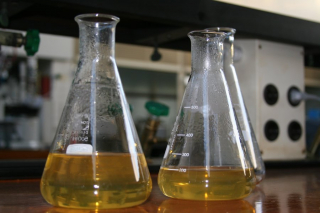hands wet in the lab
- Posted by darkeye on March 4th, 2008 filed in experiments, log
- 2 Comments »
Just started yesterday here at The Arts & Genomics Center in Leiden, but immediately I had a chance to get my hands wet. While we’re still waiting to receive the TorA-GFPmut3* E. Coli strain from Prof. Mullineaux, I started out with the pGLO Bacterial Transformation Kit from BIO -RAD. This is a simple kit tailored for high-school students, so it’s rather easy to work with. But still, during the process participants do modify the genes of the bacteria involved, so as to contain Green Fluorescent Protein, that will glow when excited by UV light.
While I’ll post a more detailed protocol description, the first step one has to do is to create the agar plates that will hold the bacteria. Because this is a gel, and it takes about 2-3 days for it to become really gel-like (starts out as a liquid), you have to do this in advance. So this is the first steps we did.
It’s rather simple, like in the kitchen, you just have to follow some sterility guidelines, such as:
- only touch sterile stuff in plastic gloves
- don’t bend over anything, as things will fall off you onto them
- and I’m sure there are a lot more I’m just not aware of 🙂
Making agar gel is really a lab-technicians work usually, but it’s good to get a hang of the complete process. So there we go:
- pour agar powder into distilled water, where the powder already includes the nutrients for the bacteria (called LB).
- shake & stir
- put into microwave, so that it boils
- shake & stir meanwhile
- as it boils, and all powder is dissolved, get it to cool
So far, so good. But we’ll have to have different kinds of this agar:
- with LB (the nutrient) only
- with ampicillin, that is close to pennicillin, and basically kills bacteria (ouch)
- with both ampicillin and arabinose, which is a form of sugar (you’ll see later why this is good)
So, while the agar with LB is cooling, we’re preparing ampicilling and arabinose, which came in lyophilized form (whatever that means). So you have to add some ‘transformation solution’ (CaCl2) to it to make it come alive. As these things die above 50 oC, we have to wait with the agar to cool below that to be able to add them to it.
So this is what we do.
All this stuff is going to end up in small plates, like petri dishes, but smaller (and made of plastic). So we spill out the following:
- 16 plates of generic agar with LB nutrient
- 16 plates of agar with LB and ampicillin
- 8 plates of agar with LB, ampicillin and arabinose
And then we wait for 2 days…
For you how’d like to do this at home: well, the kit is almost self-containing, but you’ll need some stuff that is not usually available at home, like:
- 37 oC incubator oven
- temperature controlled water bath (or controllable heat block)
- 500 ml graduated cilinder
- 1 liter Erlenmeyer flask











March 4th, 2008 at 12:29 pm
[…] plugin. Though not perfect for my aims of occasionally attaching a gallery to a page, it sort of serves the […]
March 6th, 2008 at 7:48 am
[…] LB agar created two days ago solidified in the plates, and thus we could continue with trying to resurrect the E. Coli bacteria […]